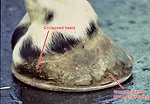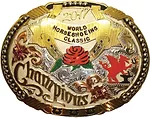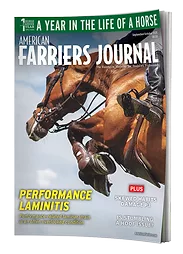Advertise Follow Us
American Farriers Journal

View Archived Issues
April 2017
Volume: 43
Edition: 3
American Farriers Journal is the “hands-on” magazine for professional farriers, equine veterinarians and horse care product and service buyers.
-
Table Of Contents
Table Of Contents
Proactive Footcare For Limiting Hind Limb Lameness
Farrier Grant Moon finds that thorough evaluation and emphasis of the trim will improve likelihood for success for managing feetRead MoreUnderstanding What You’re Seeing In Shoe Wear
Properly identifying and addressing issues shown through shoe wear will help the horse and build a good client relationshipRead MoreBetter Practices, Better Results
Hall Of Fame vet Scott Morrison shares valuable tips for improved footcareRead MoreProper Equine Diet Can Be a Difficult Balancing Act
Life Data Labs representative offers nutritional advice for horse ownersRead MoreFeet Move, Nails Don’t
Place nails to accommodate the natural function of a hoof, not hinder itRead More3 Areas Of Consideration For Better Use With Adhesives
Focusing on these core areas will deliver improved success when using these materialsRead MorePrepare Yourself for Fly Season
Entomologist offers tips to repel insects and improve your work areaRead MoreWhat You Need To Know: Drill Bits And Taps
You likely haven’t thought much about your drill bits and taps, but this quick tutorial will help you save time and moneyRead MoreTherapeutic Uses for Copper Alloy Shoes
Farrier displays benefits of application with bacteria-killing propertiesRead MoreIt Came Down To A Half-Point
After winning the World Horseshoeing Classic by a slim margin, Team GB credits team efficiency and attitude for rallyRead MoreHow To Keep Your Equine Specimens Like New
Proper care will keep your skeletons and limb models in tip top shapeRead MoreResearch Journal: April 2017
The information, ideas and opinions expressed are those of the author and do not necessarily represent those of the United States Department of Agriculture.Read More -
Featured Articles
Featured Articles
Proactive Footcare For Limiting Hind Limb Lameness
Farrier Grant Moon finds that thorough evaluation and emphasis of the trim will improve likelihood for success for managing feetRead MoreBetter Practices, Better Results
Hall Of Fame vet Scott Morrison shares valuable tips for improved footcareRead MoreIt Came Down To A Half-Point
After winning the World Horseshoeing Classic by a slim margin, Team GB credits team efficiency and attitude for rallyRead More - Digital Edition
-
Online Extras
Online Extras




















